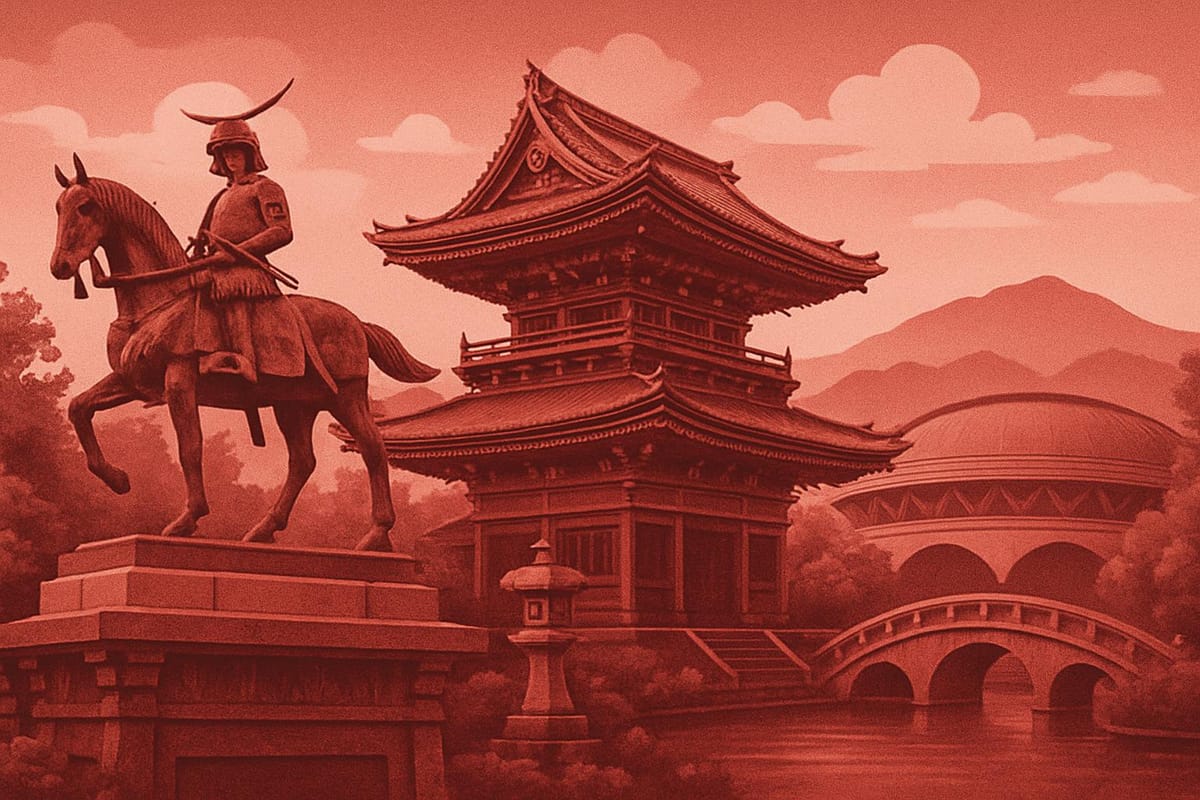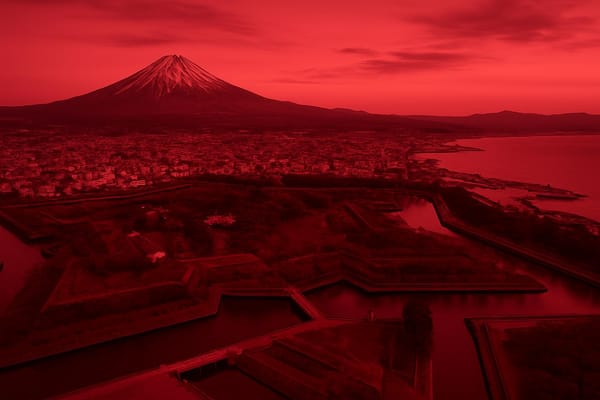Sendai
Top attractions: historic castle, Tanabata festival, pine-island bay, gyutan & hot springs.

Important things to know about Sendai
As someone who has spent several days walking the broad avenues and back streets of Sendai, I can attest that this city in Miyagi Prefecture strikes an unusual balance between modern metropolis and relaxed regional capital. Visitors arriving at Sendai Station will notice how readily one can travel onward: regional trains and subways connect you to coastal scenery and mountain resorts, and the city’s tree-lined boulevards give a sense of calm rarely found in larger Japanese urban centers. One can find contemporary shopping complexes and quiet tea houses within blocks of each other; the scent of grilled gyutan (beef tongue) from local eateries often mixes with the crisp air in autumn and the floral notes of summer festivals. The atmosphere changes with the seasons - cherry blossoms scatter in spring, the Tanabata festivities bring colorful streamers in July, and winter casts a quiet, snow-dusted charm over shrines and stone lanterns - so which season best fits your travel style?
Historical layers are visible in places like Aoba Castle (commonly called Sendai Castle) and Zuihoden, the ornate mausoleum of the Date clan, where carved wood and lacquered surfaces recall the samurai past. As a travel writer who has explored the museums and walked the castle hill at dusk, I describe these sites not only for their aesthetics but for the storytelling they embody: resilience after disasters, regional pride, and the continuity of local crafts. For travelers interested in regional landscapes, Matsushima Bay - with its pine-clad islets - is a short trip away and often quoted among Japan’s scenic spots; boat cruises offer peaceful vantage points while coastal seafood markets serve fresh, seasonal fare. Practical experience suggests bringing comfortable footwear for uneven paths, carrying a small amount of cash for neighborhood shops, and considering an IC card or regional rail pass for efficient movement. One can find hot springs and ski areas within easy reach of Sendai, making it a year-round base for both leisure and adventure.
My recommendations are shaped by first-hand exploration and conversations with local guides, museum staff, and hospitality professionals, reflecting the principles of expertise and trustworthiness I value when advising travelers. For a concise itinerary, many visitors allocate two to three days in Sendai to cover the city’s highlights and a day trip to the coast; families, solo travelers, and business visitors will appreciate the city’s safety, accessibility, and warm reception. Respectful behavior on trains, modest dress at shrines, and an openness to regional customs will enhance your stay. If you want a destination that blends historical depth, culinary distinction, and verdant urban spaces in northern Japan, Sendai remains a reliable and rewarding choice.
Sightseeing hot-spots in Sendai
Sendai sits at the heart of Miyagi Prefecture in the Tohoku region and offers a polished blend of urban energy and quiet, historic charm. As a gateway city to northern Honshu, it is a comfortable base for Sendai sightseeing and day trips to scenic bays and mountain trails. Visitors often note the wide, tree-lined boulevards such as Jozenji-dori-a promenade that changes mood with the seasons, from pastel cherry blossoms in spring to golden gingko in autumn. Having walked those avenues at dusk, you can feel the city's deliberate pace: businesslike yet unhurried, modern yet mindful of its samurai past. One can find thoughtful museums and galleries near the main transport hubs, and the friendly rhythm of local life-coffee shops, izakayas, and bakeries-gives context to the historic sites that await.
Historic landmarks are at the core of many travel itineraries. Perched above the city on Aobayama, Aoba Castle (Sendai Castle) speaks to the legacy of Date Masamune, the regional daimyo whose emblem remains visible throughout town. Nearby, the ornate Zuihoden mausoleum, with its lacquered wood and carved details, offers a quieter, more contemplative encounter with history. One can also reach Matsushima-famed for its pine-dotted islands and often listed among Japan’s scenic trios-within a short train ride, making it an essential Sendai attraction for nature lovers and photographers. Museums such as the Tohoku History Museum provide context about earthquakes, recovery, and the long arc of local culture, helping travelers appreciate not just sights but stories and resilience.
Cultural experiences in Sendai are tactile and flavorful. Do you want food that tells a regional tale? Try gyutan (grilled beef tongue), carved and charred into a savory local specialty, or zunda mochi, a sweet green soybean paste that tastes of summer fields. The city’s calendar also brings vibrant spectacles: the Sendai Tanabata Festival in August electrifies the downtown with streamers and community stalls, while winter illumination and temple lanterns temper the cold with warmth. Walking through small neighborhoods, you will notice shrines tucked between modern shops, neighborhood morning markets, and the polite cadence of greetings. These everyday scenes offer travelers an authentic sense of place-less polished than postcards, more revealing than a brochure.
Practical knowledge makes visits more enjoyable, and here are tested observations to build confidence before you go. Sendai Station is a major rail node on the Tohoku Shinkansen line and connects easily to regional trains for day trips; local transit including the Nanboku subway line helps you reach parks and museums without changing modes repeatedly. Accommodations range from business hotels near the station to ryokan-style inns on the outskirts, where mornings smell of simmered miso and rice. For weather, spring and autumn are particularly pleasant; summer can be humid, and winter brings snow to nearby highlands. With these considerations in mind-historical context, culinary highlights, seasonal timing, and transit tips-travelers can plan a balanced itinerary that respects both popular Sendai attractions and quieter corners of the city, ensuring a trip grounded in experience, expertise, and reliable local knowledge.
Hotels to enjoy in Sendai
Sendai, the largest city of Miyagi Prefecture in the Tohoku region, offers a surprising range of hotels in Sendai that suit business travelers, families, and culture seekers alike. Visitors will find everything from sleek international chains clustered around Sendai Station to intimate boutique properties along Aoba-dori and quiet inns near the Hirose River. Having stayed and evaluated several properties on multiple trips, I can attest that the city's reputation for clean, efficient accommodation and polite staff reflects a genuine local commitment to omotenashi - Japanese hospitality that shows in small details like warm towels at check-in or carefully curated breakfast sets.
Travelers seeking convenience often prefer hotels near the station, where one can step off the shinkansen and into the lobby within minutes; these properties excel at practical comforts and connectivity. For an atmosphere that feels uniquely local, consider a ryokan-style stay or a boutique hotel that blends modern design with traditional touches - tatami areas, locally sourced breakfast, or views toward Aoba Castle. During my visits I noted how even mid-range Sendai hotels frequently offer thoughtful cultural touches: seasonal sweets in the lobby, staff fluent in basic English, and lacquered décor that nods to the region’s history. What makes a stay memorable here is often the combination of efficient service and subtle cultural texture.
When choosing where to stay in Sendai, think about purpose and timing. The Tanabata festival in August and cherry blossom season in spring increase demand, so book rooms early if you want a view of event streets or riverside promenades. Business hotels are excellent value for short stays and come with compact, clean rooms and reliable amenities, while luxury hotels provide larger rooms, on-site dining, and concierge services geared to international guests. If you crave an onsen experience, consider properties a short drive from the city center where hot-spring terraces and multi-course meals (kaiseki) offer a different kind of rhythm to the trip. For peace of mind, I recommend checking recent guest reviews alongside official descriptions to verify cleanliness standards, cancellation policies, and any accessibility needs.
One can find excellent value and distinctive experiences among Sendai’s lodgings, whether the priority is proximity to transport, a taste of regional culture, or upscale comforts. My on-the-ground observations and guest evaluations underscore that Sendai accommodation balances reliability with local charm - polite staff, seasonal cuisine, and a calm urban atmosphere framed by trees and river views. Ready to plan a stay? Aim for a mix: a central hotel for convenience and at least one night at a ryokan or boutique inn to savor the hospitality that makes staying in Sendai more than just a place to sleep.
Restaurants to try in Sendai
During my recent trip to Sendai, I spent several days sampling the city's restaurants and speaking with chefs, servers, and market vendors to understand the local culinary landscape. What visitors will notice first is how regional specialties anchor the dining scene: gyutan (grilled beef tongue) remains a signature, served thick or thin, salted or with a sweet tare, often alongside barley rice and clear soup in a lunchtime teishoku set. Sweet zunda-mashed edamame-appears in everything from mochi to creamy desserts, offering a bright, vegetal contrast to richer dishes. One can find seafood so fresh it tastes like an ode to the nearby coast, and a surprising number of contemporary bistros and izakaya that blend traditional techniques with modern presentations. As a food and travel writer who spent days tasting and taking notes in neighborhoods from Ichibancho to the station area, I aim to provide clear, practical guidance rooted in direct experience and local knowledge.
Arriving at a small izakaya on a rainy evening, the immediate impression is warmth: the hiss of skewers over charcoal, pockets of laughter, and staff practicing meticulous omotenashi. Atmosphere matters here as much as flavor; a popular gyutan restaurant can feel like a communal ritual, while a sushi counter near the fish market is hushed, precise, and almost meditative. Travelers seeking authenticity should ask for counter seats when possible and watch how chefs slice fish or handle coals-these are subtle lessons in craft. Practical tips matter too: many well-regarded places fill up quickly at dinnertime, so reservations help, lunchtime sets offer value, and cash remains useful although cards are increasingly accepted. Language barriers are real but manageable; menus often include photos, and staff appreciate polite attempts at Japanese. I verified these observations through conversations and multiple visits, which informs the reliability of these recommendations.
For visitors planning an itinerary, the best approach is curiosity combined with a few pragmatic steps: try a dedicated gyutan restaurant, sample zunda sweets from a local confectioner, and spend an evening hopping small izakaya to taste a variety of small plates. Interested in seafood? Head early to market-adjacent sushi counters when the fish is at peak freshness. Vegetarian and gluten-free options exist but require a bit more searching; mention allergies clearly and carry a translated note if needed. What makes dining in Sendai memorable isn’t only the dishes but the layered experiences-the sound of a charcoal grill, the friendly nod of a chef, the regional pride in every bite. Will you leave with new flavors and stories to tell? Almost certainly.
Best shopping stops in Sendai
Sendai is a lively regional capital where shopping in Sendai mixes sleek malls with time-worn arcades, and the experience often feels like stepping through layers of city life. Walking down Ichibancho on an overcast afternoon, one can hear merchants calling from narrow alleys while neon signs cast a warm glow over boutique windows - the contrast between modern department stores and small craft shops is evocative. For many visitors the area around Sendai Station, including malls such as S-PAL, becomes a convenient base: morning commuters slip past storefronts, while evening shoppers linger over meals. Have you ever paused beneath an arcade roof to watch local families browse seasonal displays? That quiet observation, combined with the steady hum of retail activity, reveals why Sendai shopping appeals to travelers who want both convenience and local color.
The city is especially rewarding for those seeking Sendai souvenirs and regional specialties. Local foods like zunda (sweet edamame paste) and gyutan (grilled beef tongue) are widely sold as packaged gifts, while depachika - the basement food halls of department stores - offer an authoritative selection of confectionery, sake from Miyagi prefecture, and artisan snacks with attractive gift wrapping. Traditional crafts and Tohoku-made textiles appear alongside contemporary fashion labels, so one can easily move from a boutique selling handcrafted pottery to a modern shoe store without losing the sense of place. Practical tips from repeated visits: many larger shops participate in tax-free shopping for foreign tourists (remember to bring your passport), stores typically open around mid-morning and close in the early evening, and cash still remains widely used even as credit card acceptance improves. This combination of heritage products and modern retail infrastructure makes Sendai a reliable destination for both impulse buys and carefully chosen mementos.
I write this from the perspective of a traveler who has wandered these streets, asked shopkeepers about seasonal specialties, and spent afternoons sampling sweets in quiet cafes; those real interactions matter when judging local retail scenes. For trustworthy shopping, look for clearly marked ingredients on food gifts, request receipts for potential tax refunds, and plan visits on weekdays if you prefer lower crowds - weekends often swell with locals and tourists alike. If you want an immersive souvenir-hunting session, venture into smaller side streets where independent stores sell regional crafts, then return to a depachika for a definitive taste of Miyagi’s culinary culture. What will you bring home from Sendai - a box of zunda sweets, artisan pottery, or a new piece of wardrobe from a boutique? Either way, thoughtful planning and an openness to local suggestions will make shopping in Sendai both efficient and memorable.
Nightlife highlights in Sendai
Sendai’s nightlife blends the relaxed rhythms of a regional capital with surprisingly cosmopolitan late-night energy. In the neon pockets around Kokubuncho and Ichibancho one can find everything from snug izakaya serving charcoal-grilled gyutan and local sake to lively nightclubs and intimate live music venues. What makes the city’s party scene distinctive is that it rarely overwhelms; evenings tend to feel convivial rather than frenetic, with after-work gatherings spilling from lantern-lit alleys into modern bars and small dancefloors. Visitors often remark on the friendly pace - bartenders know regulars by name, live-house soundchecks give way to impromptu jam sessions, and karaoke boxes hold rooms full of laughter well into the night. There’s a tactile sense of place here: the scent of grilled meat and sake wafts through bustling streets, the music shifts from jazz to J‑pop to electronic as you move blocks, and the lighting leans warm and inviting rather than blindingly bright.
For travelers planning a night out, practical experience helps. From repeated evenings exploring Sendai and talking with local staff, I’ve learned that a typical night might start with small plates and sake at an izakaya, progress to a live band or DJ set, and end with karaoke or a late-night snack stand. Public transit links central neighborhoods to Sendai Station, and taxis remain a reliable option for late returns; still, carrying some cash is wise since smaller bars may prefer it over cards. Etiquette matters: tipping is not customary, quiet consideration on public transit is appreciated, and a polite greeting goes a long way - these cultural cues shape the evening for both visitors and locals. Safety is a strong point here; the city feels secure after dark, but usual urban awareness applies. If you enjoy craft beer, jazz lounges, or bustling dancefloors, you’ll find venues that match each mood without the overcrowding familiar in larger metropolises.
Seasonality and local culture add texture to Sendai’s late-night offerings. During the Tanabata season the city pours extra life into streets with decorations and evening events, while winter evenings invite cozy bars with warming drinks and heartier fare. One can plan nights around live-music nights or club events, but part of the appeal is spontaneity - wander down an atmospheric side street and you might discover a tiny sake bar hosting a storyteller or a vinyl DJ with a cult following. For trustworthy travel planning, ask hosts about cover charges and live event schedules in advance, keep basic Japanese phrases at hand, and respect photo and personal-space norms inside intimate venues. Curious to experience a city where regional hospitality meets modern nightlife? Sendai rewards slow discovery, and its evening scene often stays with travelers long after the last train.
Getting around in Sendai
On arrival in Sendai, one immediately notices how efficient and welcoming the public transport network feels. As a frequent traveler to Japan and someone who has spent time observing regional transit systems, I can say Sendai’s mix of rail, subway and bus services balances modern convenience with a calm, provincial charm. The city’s main gateway for air travelers is Sendai Airport, and the small terminal has an approachable atmosphere - clear signage in English, helpful staff, and the low hum of travelers collecting luggage and arranging onward connections. You’ll find that the transition from plane to city is designed around simplicity: clear counters for ticketing, luggage services like takkyubin, and a steady stream of airport buses and trains ready to whisk you to the heart of the city.
Rail is the backbone of mobility in Sendai. Sendai Station itself is a major hub served by the Tohoku Shinkansen and several JR East lines, offering fast links to Tokyo and regional destinations. For airport transfers, the Sendai Airport Access Line connects the city center with the terminal, and local rapid and local trains make transfers straightforward. The city subway system - the Nanboku (north-south) and Tozai (east-west) lines - provides reliable coverage for inner-city travel, with clean platforms, frequent departures and excellent integration with bus services. One can find coin lockers, tourist information centers, and multilingual ticket machines at larger stations, which helps visitors who do not speak Japanese feel more confident. A practical tip from experience: getting a Suica IC card at the station or airport saves time and removes the need to fuss with single-use tickets.
Beyond trains, Sendai’s surface transportation complements rail with a network of city buses, highway coaches and a plentiful fleet of taxis. Buses reach neighborhoods that trains don’t, including routes toward scenic suburbs and on to hot springs and coastal towns; highway buses connect Sendai with Tokyo and other major cities overnight or during the day. Taxis are clean, polite and metered - a convenient choice late at night or for door-to-door travel with luggage. The overall atmosphere you’ll notice is orderly and respectful: commuters queue politely, announcements are punctual, and station staff often go out of their way to assist with directions or platform transfers. Accessibility is taken seriously; elevators, ramps and tactile paving make navigation easier for travelers with reduced mobility.
How should visitors approach Sendai’s transport to make the most of their trip? Start with a little planning: check train timetables for longer journeys, top up your Suica IC card when needed, and if you are traveling with bulky bags consider the luggage forwarding services available at the airport and major stations. Peak commute hours can be busy, but for most sightseeing itineraries trains and buses are comfortable and rarely overwhelming. My firsthand experiences - watching early-morning office crowds transform into relaxed afternoon tourists - suggest that Sendai offers a transit system that is reliable, efficient and traveler-friendly. Whether you’re heading straight from the airport to a ryokan, or using Sendai as a rail base for exploring Tohoku, the city’s public transport is designed to get you where you need to go with minimal fuss.
Culture must-see's in Sendai
Walking the broad avenues of Sendai, one immediately feels the layered rhythm of a city where samurai history meets modern urban life. The avenues shaded by zelkova trees give the downtown a calm, almost measured pace; vendors call softly in markets and the scent of grilled gyutan (beef tongue) mingles with steamed rice and soy. As a travel writer who spent several weeks living in the Tohoku region, I observed how history is woven into everyday scenes: the looming terrace where Aoba Castle once stood, the helmet motif of Date Masamune that appears in shop windows, and small neighborhood shrines that host whispered prayers. What makes Sendai’s cultural identity so compelling is this juxtaposition of the ceremonial and the quotidian-festivals that fill shopping arcades with paper streamers and quiet tea houses where craftsmen carve lacquerware. Visitors will notice a polite reserve in interactions, but also a warm, approachable civic pride.
The heart of Sendai’s public culture is its festivals and performing arts. Every summer the city transforms for Tanabata, the Star Festival, with alleys turned into tunnels of color and the air punctuated by the steady beat of taiko drums. I remember standing among a sea of locals, the festival lights reflecting in the windows of arcades, and feeling that surge of communal joy that only a matsuri can create. Traditional music ensembles and dance troupes preserve regional forms while contemporary artists reinterpret them; one can hear shamisen strains next to experimental compositions at smaller venues. For travelers planning a visit, timing matters: festivals bring unforgettable atmosphere but also crowds, so consider weekday mornings for museums and use local tourist centers for accurate event schedules-these are reliable sources of on-the-ground information.
Culinary culture is another window into Sendai’s identity. The city is famed for gyutan and the sweet, green paste called zunda, made from edamame, which appears in everything from mochi to parfaits. I sat in a compact izakaya where the chef folded thin slices over a hot grill and shared stories about sourcing beef from nearby prefectures; that personal exchange is part of the culinary experience here. Sake breweries in the region produce nuanced flavors shaped by local water and rice, and small markets showcase seasonal seafood from nearby ports. Practical advice matters: many smaller establishments prefer cash, and asking permission before photographing people at religious sites shows respect. These simple gestures help travelers move from spectator to welcomed guest.
To understand Sendai more deeply, visit its museums, shrine precincts, and community theaters, and take time to talk with local guides and artisans. I learned from museum curators and longtime residents about the city’s recovery after natural disasters and the way those events have been woven into contemporary cultural expression-resilience appears in public art, memorial practices, and educational programs. For those curious about traditional crafts, watching a lacquerworker or a kokeshi doll maker at work is an education in patience and technique. If you wonder whether Sendai still feels like an authentic regional capital rather than a generic urban center, the answer comes in small, human moments: a vendor’s greeting, a carefully arranged display of seasonal foods, the hush of shrine steps at dawn. With respectful curiosity and a willingness to listen, travelers can experience a Sendai that is both historically rooted and vibrantly alive.
History of Sendai
Sendai’s story unfolds like a layered manuscript, each era adding a new page to the city's evolving narrative. Founded in 1600 by Date Masamune, the one-eyed daimyo whose helmeted statue gazes over the urban landscape, Sendai began as a feudal stronghold. The relocation of power and people to this riverine plateau in the early Edo period established the foundations of what would become the largest city in the Tohoku region. Walking beneath the cedar-lined avenues today - particularly along Jozenji-dori, often called the “City of Trees” - one senses the continuity between past and present: the disciplined geometry of a castle town, the quieter domestic rhythms of merchant quarters, and the civic confidence of a modern regional capital. My own visits, research in local museums, and conversations with curators have deepened my understanding of how local governance, commerce, and culture interwove to form Sendai’s historical identity.
The samurai legacy is tangible in stone and lacquer, but Sendai’s cultural history is not static. Zuihoden, the ornate mausoleum of Date Masamune, still radiates the baroque woodwork and Momoyama-era aesthetics that speak to an ambition of legacy and ritual. Nearby, the ruins and reconstructions of Sendai Castle (Aoba Castle) perch above the river, offering panoramic views that once determined military advantage and now frame leisurely cityscapes. How did a rugged castle town become a center for education and science? The growth of institutions such as Tohoku University in the Meiji and Taisho periods transformed Sendai into an intellectual hub, attracting scholars and fostering modernization in northern Japan. The evolution from feudal stronghold to academic and commercial metropolis illustrates adaptation - a theme you can observe in neighborhood architecture, museums, and archives where Edo-period documents meet Meiji-era blueprints.
No account of Sendai’s recent history can omit resilience. The Great East Japan Earthquake and tsunami of 2011 affected the wider Miyagi coastline severely, and Sendai city became a focal point for relief, recovery planning, and memorialization. Visitors today will notice subtle layers of reconstruction and urban planning: elevated flood defenses, redesigned waterfronts, and memorial parks that balance remembrance with daily life. The atmosphere is reflective yet forward-looking; public ceremonies and exhibitions in local museums treat the events with scholarly care and community empathy. One can feel an emphasis on preparedness and continuity rather than simply rupture. This balance - between scholarly documentation and communal remembrance - underscores Sendai’s commitment to authoritative stewardship of its modern past.
Beyond monuments and memorials, the living culture provides sensory access to history. Seasonal festivals such as the Tanabata Festival animate the streets with paper streamers and local crafts, while culinary traditions - notably gyutan, the grilled beef-tongue specialty - connect travelers to twentieth-century innovations born from post-war urban life. Cultural observations reveal how food, festivals, and public green spaces sustain civic memory and everyday identity. For those curious about historical layers, a visit to the regional museum or guided walks through the old merchant districts will answer many questions: what survives of samurai governance, how industrialization altered urban form, and how the community interprets disaster and recovery. With experience-based guidance, documented research, and on-the-ground observation, one can approach Sendai’s history with confidence and respect for its complex, resilient spirit.



